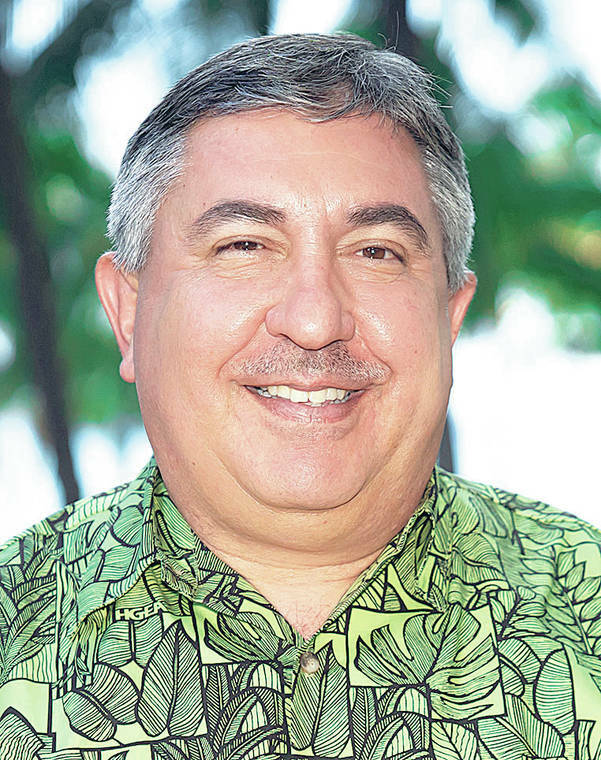County officials, union work to solve dispatcher shortage
Representatives of the Hawaii Government Employees Association met Tuesday with Hawaii Fire Chief Kazuo Todd and other members of Mayor Mitch Roth’s administration to come up with a plan to rectify a severe shortage of fire dispatchers.
Representatives of the Hawaii Government Employees Association met Tuesday with Hawaii Fire Chief Kazuo Todd and other members of Mayor Mitch Roth’s administration to come up with a plan to rectify a severe shortage of fire dispatchers.
HGEA Executive Director Randy Perreira, Todd and Cyrus Johnasen, Roth’s spokesman, said discussions will continue today, and all expressed optimism that a plan will be formulated, perhaps by week’s end, to alleviate shortages in the near term and mitigate conditions that caused the shortage in the long term.
ADVERTISING
“We’re sharpening our pencils as we look at solutions to deal with the longer-term issues — like how do we prevent our staffing for dipping like this in a future? How do we retain staff?” Todd said Wednesday.
Perreira said he wasn’t present at Tuesday’s talks, but his staff reported discussions were “very good” and that HGEA is “very optimistic” solutions will be found.
Todd issued a memo May 4 saying fire dispatchers were moving temporarily from Hilo’s Central Fire Station into the Hawaii Police Department’s dispatch center at the Hilo Police Station because of short staffing. That prompted a letter the next day to Roth from Perreira, whose union that represents Big Island fire and police dispatchers.
In the letter, Perreira described the move as an “unprecedented and drastic action.”
“Obviously, we have serious concerns about the potential negative impact this decision will have on public safety, not to mention the undue burden this places on existing dispatchers and uniformed officers,” Perreira wrote.
According to Johnasen, two fire dispatchers are currently on leave and another recently resigned, “so we have only four trained dispatchers for fire, anyway, that are able to work at any given time.”
Perreira’s letter said the county “has failed to make sincere efforts to recruit dispatch personnel and retain the dispatchers currently on the rolls.”
“Our members report having to work under difficult circumstances, including a high turnover rate, working up to 13 days straight with no days off, 12-hour shifts with no lunch breaks, being unable to keep up with the volume of calls coming into the dispatch unit, and even being asked to wear their telephone headsets to the bathroom,” the letter states. “They’ve watched colleague after colleague leave the department because working conditions are so poor.”
Todd didn’t dispute the allegations, saying. “You know, everything is perspective.”
“I think they’re focusing in on things that they are concerned with, and there’s some validity to those concerns,” he added.
Johnasen said there currently is a class training seven fire dispatcher prospects.
“I don’t know how much longer they have in training, but when they’re done, they’ll be online, and it will alleviate a lot of our current staffing issues,” he said.
The county on Monday posted a job opening on its website for fire dispatchers, with annual pay starting at $47,988 and a $3,000 recruitment incentive. Johnasen said the county is looking to hire two more dispatchers in addition to the seven trainees.
Perreira said the union is seeking differential pay for dispatchers working extra hours or hours outside their normal shifts, which he said fire dispatchers in other counties receive.
“The current situation is, obviously, very problematic, because aside from whatever anxiety and stress the short staffing is causing on the job, it’s also having an impact on their personal lives,” he said Wednesday. “Because the few staff that are left are being called upon to do even more.”
Another area of concern is the prospect of police dispatchers receiving calls for emergency medical services.
“Right now, fire is handling those medical calls,” Todd said Wednesday. “However, we do have a few police dispatchers who have gone through our courses in the past. And we’re also scheduling courses in the future so we can potentially get more of them trained up, if necessary.
“We probably, if all goes well, won’t need them to do so. But it doesn’t hurt to have that cross-training.”
Both sets of dispatchers are currently scheduled to move in the first quarter of 2024 to an estimated $33 million centralized dispatch center, which is under construction adjacent to Mohouli Senior Housing in Hilo. Training dispatchers to answer calls for all services could be in the works for the long term, Todd said.
“It’s years away before we could even consider things like that,” he said. “But one of the reasons we’ve been looking to build a dispatch center where we’re co-located is more cohesive interaction and operations.”
Perreira said that, for now, he’s hoping to alleviate anxiety by “following up with affected employees” to get feedback and make sure they’re aware of what’s going on.”
“For right now, we’re attempting to make sure there’s support that can be provided to both police and fire dispatch — because this is going to be trying for both sides,” he said. “We’re very hopeful that the progress will kind of bolster everybody and … that we’ll be able to wrap things up this week, which is certainly the expectation and desire. The problem’s not going to be solved overnight.
“But the mere fact that there’s some movement, and we will hopefully have a plan developed by the county … would be very encouraging to the employees going forward and that kind of will keep them going.”
Email John Burnett at jburnett@hawaiitribune-herald.com.





